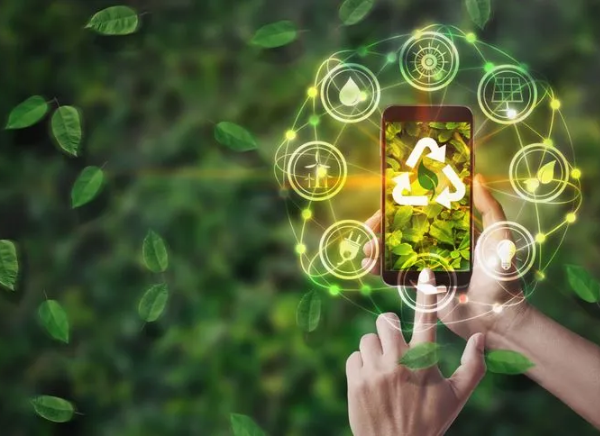
Technology is a powerful ally in the fight against climate change and promoting environmental sustainability; it can help us reduce greenhouse gas emissions, adapt to the impact of a changing climate, and use natural resources more efficiently.
First, technology can help combat climate change by easing the transition to clean energy sources, such as solar, wind, and hydropower. It allows providers to roll out Smart Grids, which are more efficient and reliable than traditional ones. ICT can also manage distributed energy resources like solar panels and wind turbines, helping make renewable energy more reliable and affordable. These sources can reduce our dependence on fossil fuels, the main drivers of global warming. Technology can also help us improve the energy efficiency of our existing products and devices by using smart devices, sensors, and data analytics to optimize energy consumption and reduce waste.
Another way that technology can help promote environmental sustainability is by supporting circular economy practices, such as reuse, recycling, and remanufacturing. These practices can extend the life cycle of products and materials, reduce waste generation, and save natural resources. Further, using digital tools like simulation, 3D printing, and artificial intelligence to design more sustainable products and services can create more efficient, durable, and adaptable solutions.
Additionally, breakthroughs in ICT are helping to protect the environment indirectly. For example, 5G networks are optimized to transmit data at a fraction of the energy consumption per bit of 4G. This leads to enormous climate gains when set against the vast amounts of data sent through modern mobile networks daily.
Technology can also efficiently monitor and track environmental conditions, such as air and water quality, providing information to help us identify and address environmental problems. Technology can also be used to develop early warning systems for climate-related disasters, such as floods and droughts. The Pangu AI Weather model developed by Huawei illustrates the seamless intersection of technology and environment.
The Pangu AI Weather model was recently demonstrated in a groundbreaking paper published by HUAWEI CLOUD in one of the world’s top scientific journals, Nature, highlighting how AI, powered by the limitless power of cloud, is a game changer in global efforts to mitigate the effects of extreme weather events. Pangu-Weather is the first AI prediction model to demonstrate higher precision than traditional numerical weather forecast methods. The model enables a 10,000x improvement in prediction speed, reducing global weather prediction time to seconds. The model can accurately predict in seconds fine-grained meteorological features, including humidity, wind speed, temperature, and sea level pressure. The paper provides independent verifications of these capabilities.
Indeed, Huawei is an example of a company leading the way in using technology for environmental sustainability. Guided by its pledge of “Tech for a Better Planet,” Huawei is committed to using its expertise to help the world address climate change.
The company founded Huawei Digital Power in 2021 to address key areas in the global energy transition: Smart PV, data center facilities, electric vehicles, site power, and integrated energy solutions. Huawei Digital Power combines digital and power electronics technology to provide low-carbon solutions to end-users that are secure, simplified, and green. Using AI, cloud, and big data will facilitate more efficient operation and maintenance so enterprises can provide clean and stable power to society.
In its 2022 Sustainability Report, Huawei highlighted its multifaceted approach to sustainability. In 2022, the company increased its usage of renewable and clean energy. Throughout the year, Huawei used 390 million kWh of electricity from renewable energy sources and 1.8 billion kWh from clean energy sources, up 25% and 15% yearly, respectively. Huawei campuses in Shenzhen and Dongguan are now fully powered by clean energy. In addition, by the end of 2022, Huawei digital power solutions had helped customers generate 695.1 billion kWh of green power, and 220 billion kWh of the energy was generated in 2022 alone. This means that Huawei helped generate over 40 times more green power than the power Huawei consumed in 2022.
One of the most effective ways to reduce the environmental impact of electronic products is to reuse e-waste and recoup its value. Huawei follows a business model incorporating circular economy practices and a closed-loop value chain. With the help of specialist suppliers, only 0.63% of the e-waste from Huawei ICT business ended up in landfills, and no e-waste from Huawei consumer business went to landfills. Through Huawei’s global recycling system, the company works with scrap service providers to recycle the raw materials of e-waste in more than 170 countries and regions worldwide. In 2022, Huawei disposed of 13,404 tons of ICT e-waste, only 0.63% of which was landfilled, and recycled and disposed of 2,884 tons of smart device e-waste, none of which was landfilled.
The Middle East is well-positioned to take advantage of the opportunities technology offers for environmental sustainability. The region has abundant solar and wind resources, which can be used to generate clean energy. Additionally, the region has a robust ICT infrastructure, which can be used to support the development and deployment of sustainable technologies.
In Jordan, the government is pushing ahead with plans to expand the use of renewable energy sources to half its total energy mix by 2030. The country today ranks third in the Arab world after Egypt and Morocco in renewable energy production, which stood at around 2,526 megawatts (MW) in 2022.
Technology is not a silver bullet for addressing all environmental challenges. Our increasingly digital lives add pressure on the environment by increasing energy demand, creating electronic waste, and disrupting ecosystems. Therefore, we must be mindful of how we use technology and what trade-offs we make. We also need to complement technology with other sustainable measures, such as changing our consumption patterns, adopting green policies and regulations, and raising awareness and education on environmental issues. Only then can we harness the full potential of technology to create a more sustainable world.